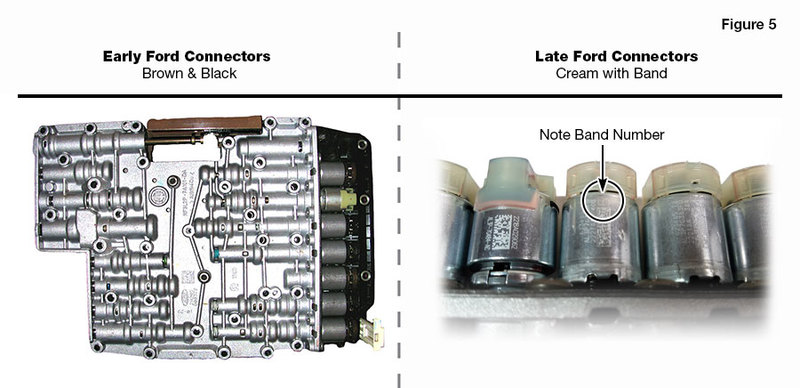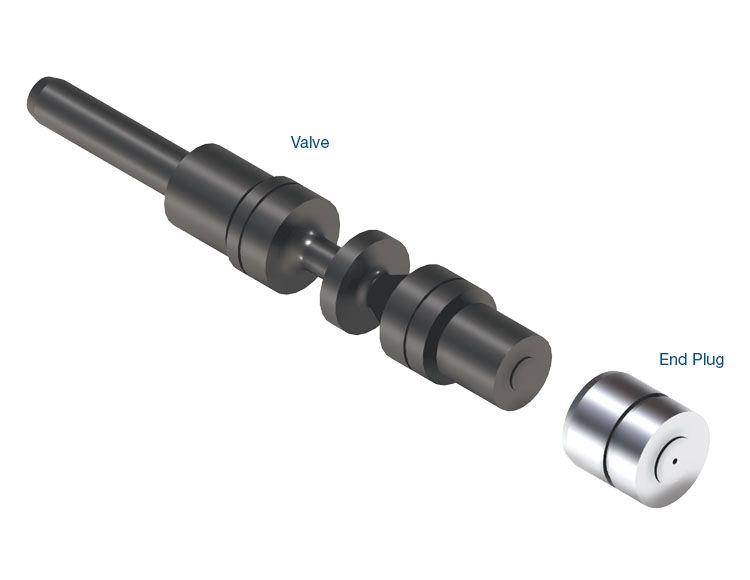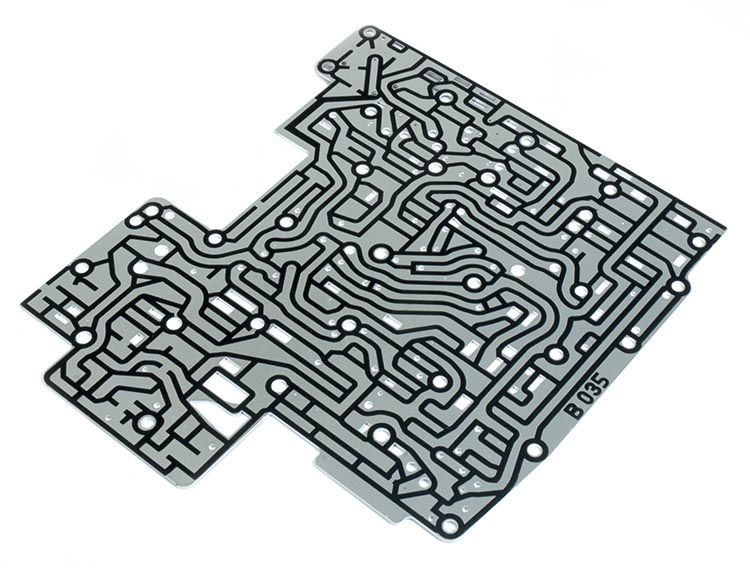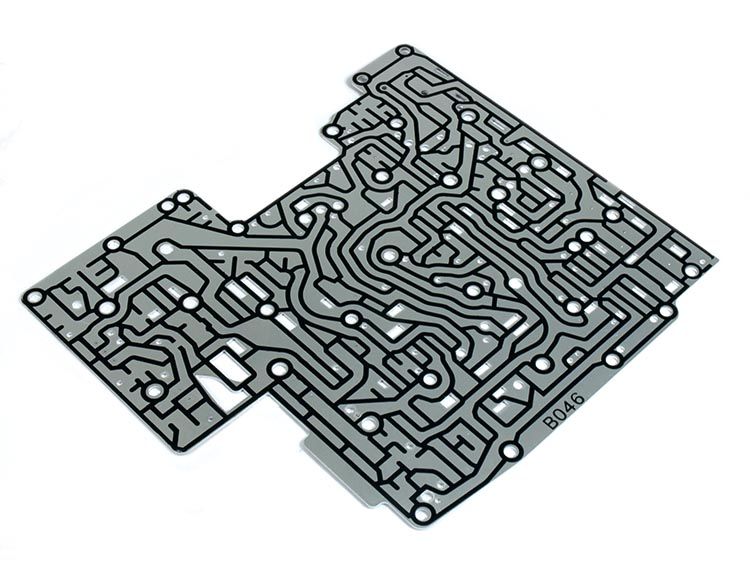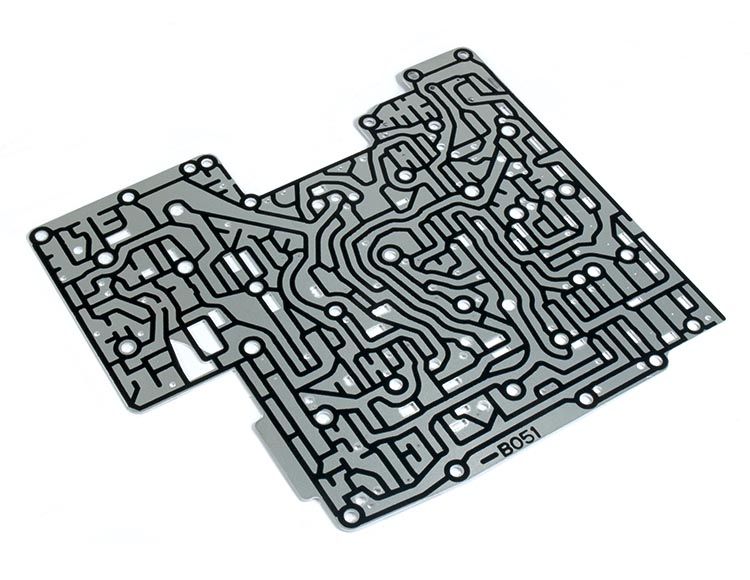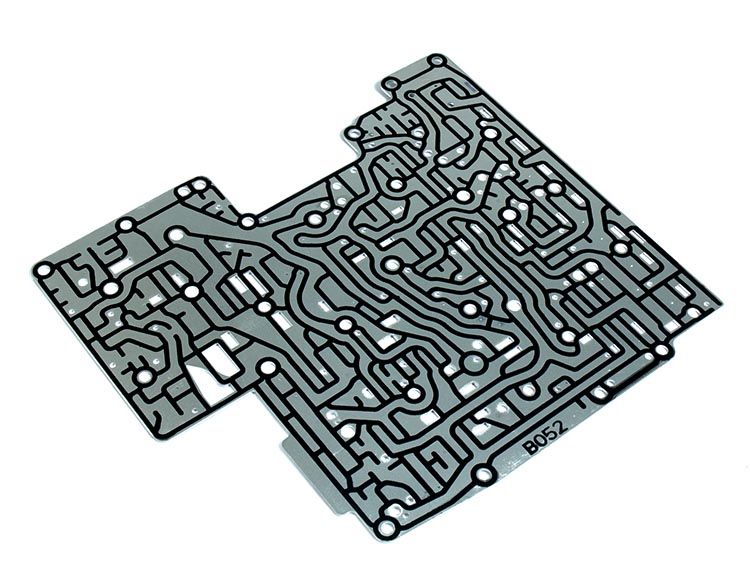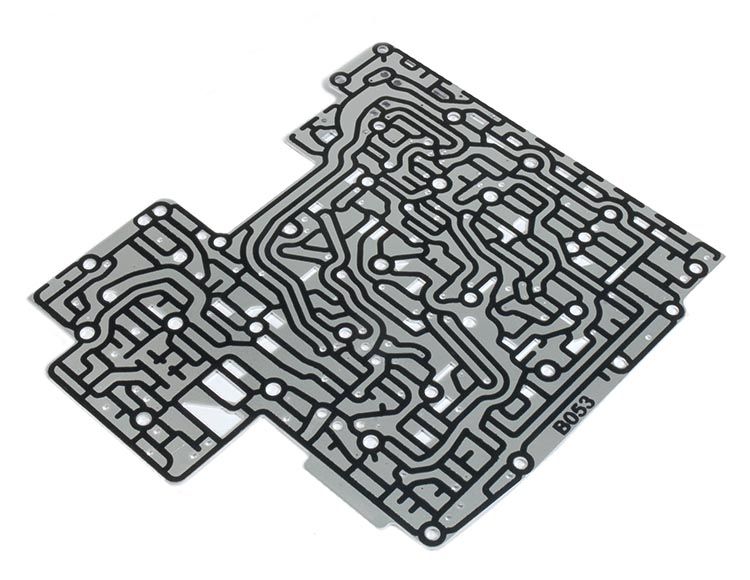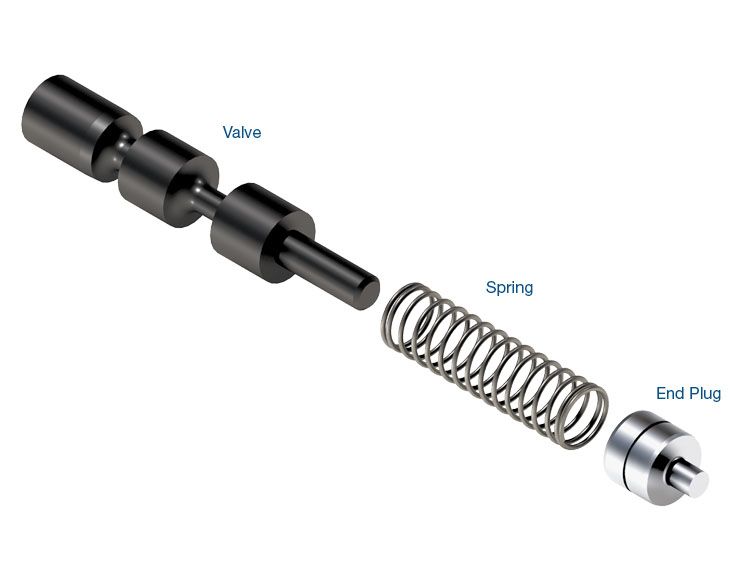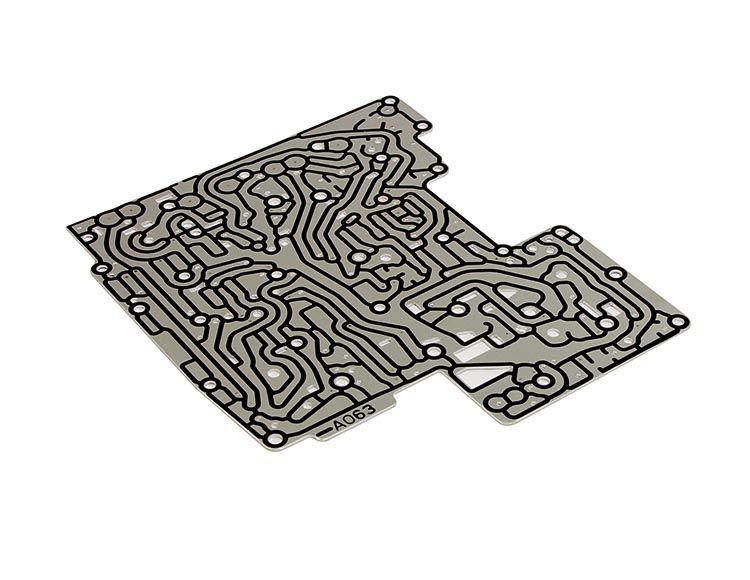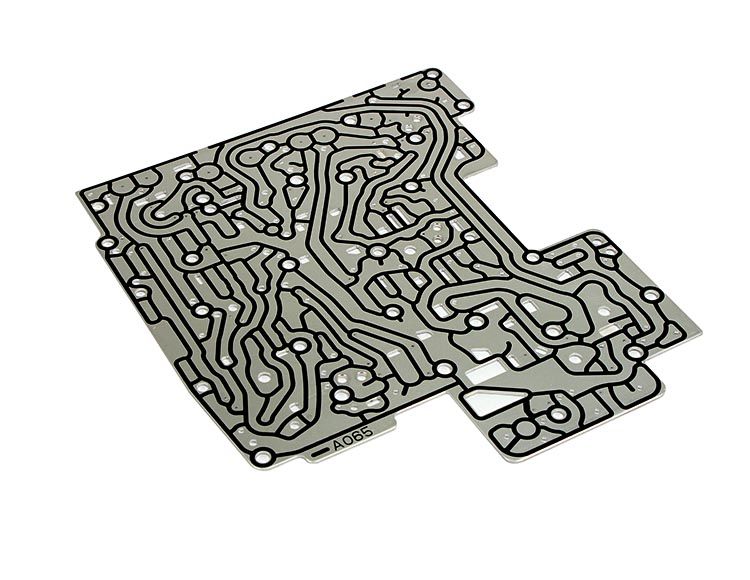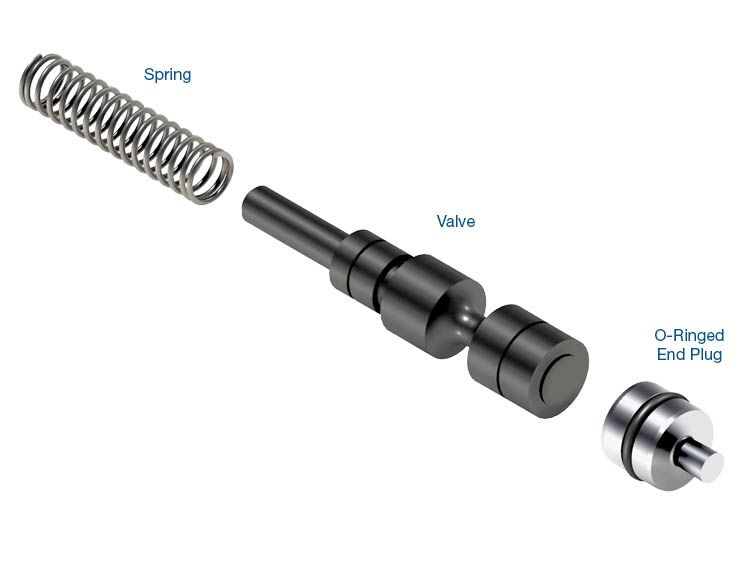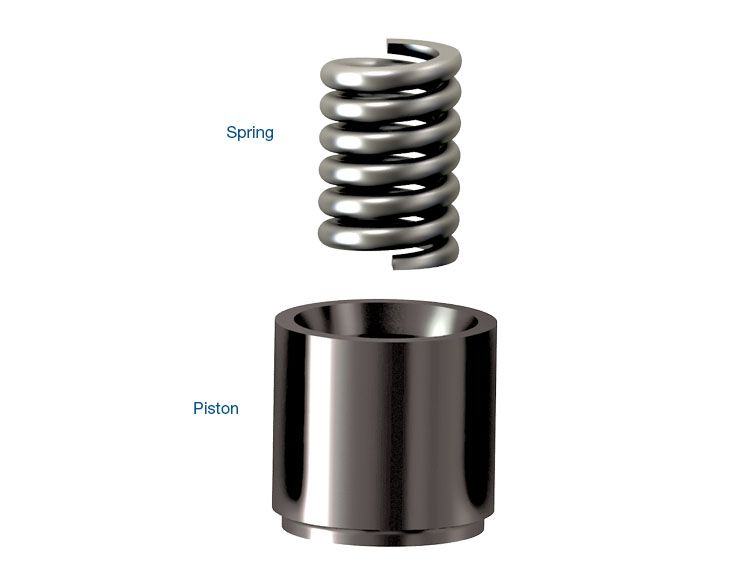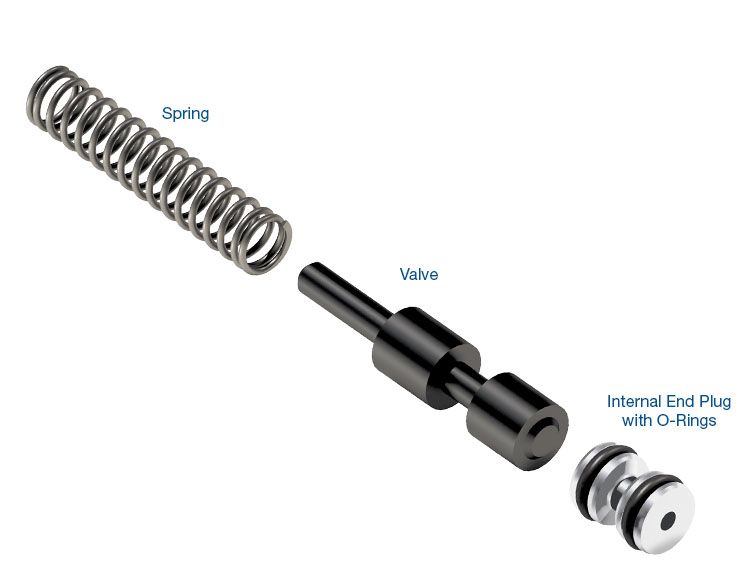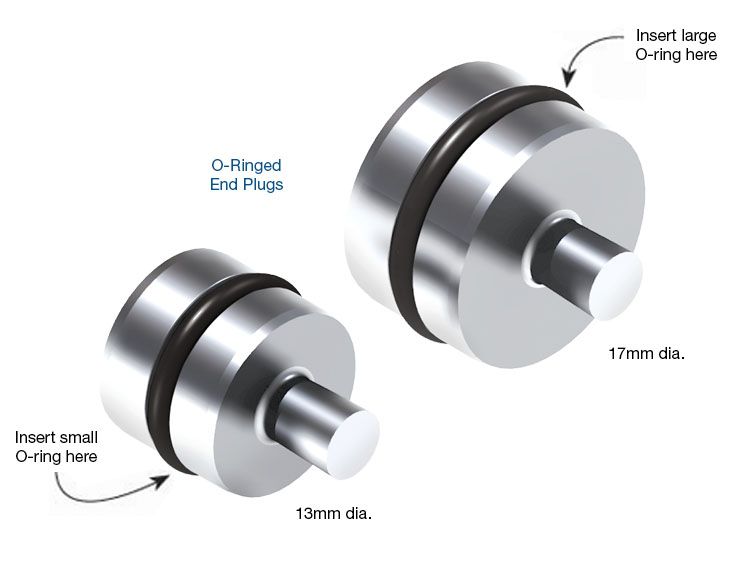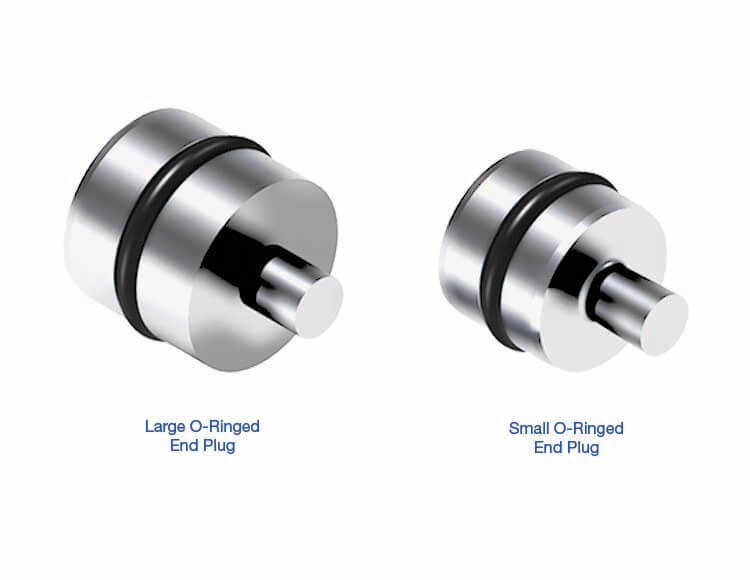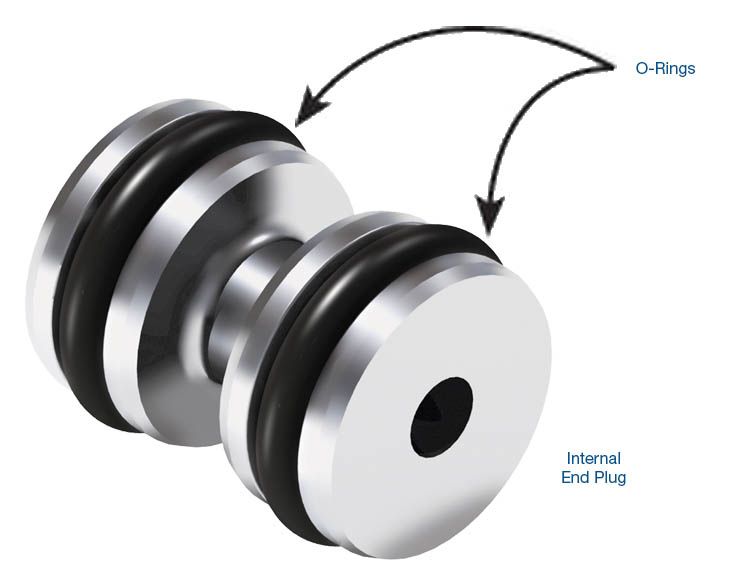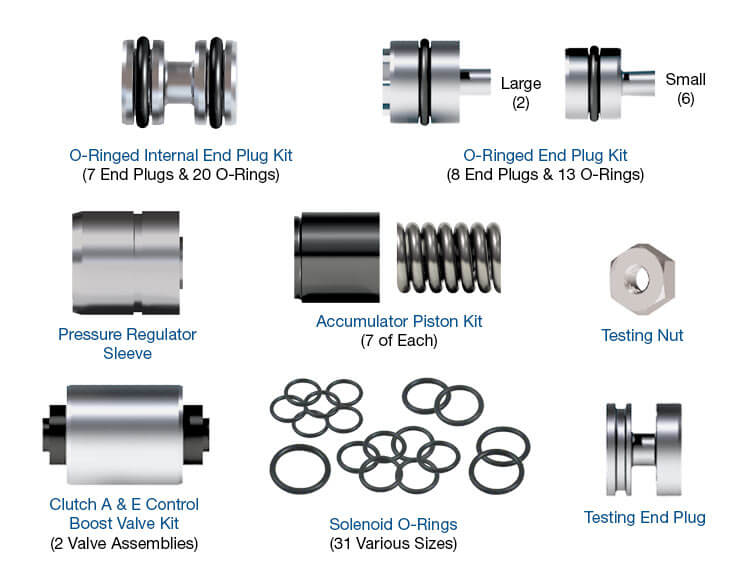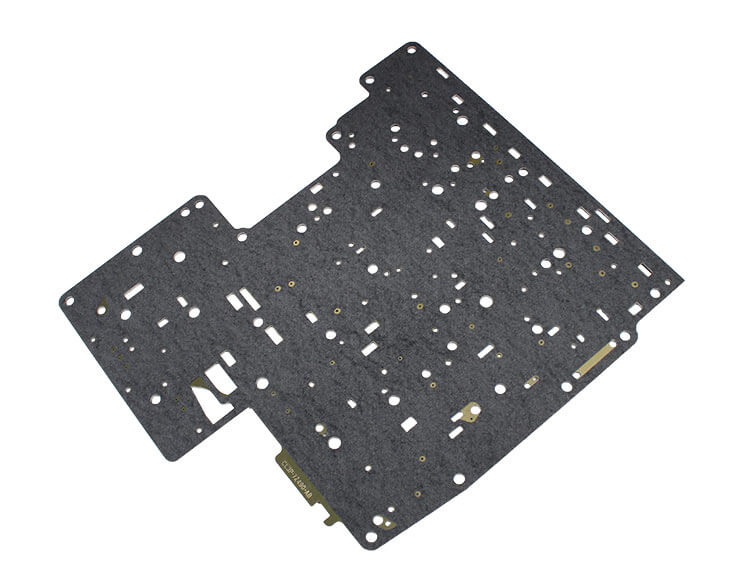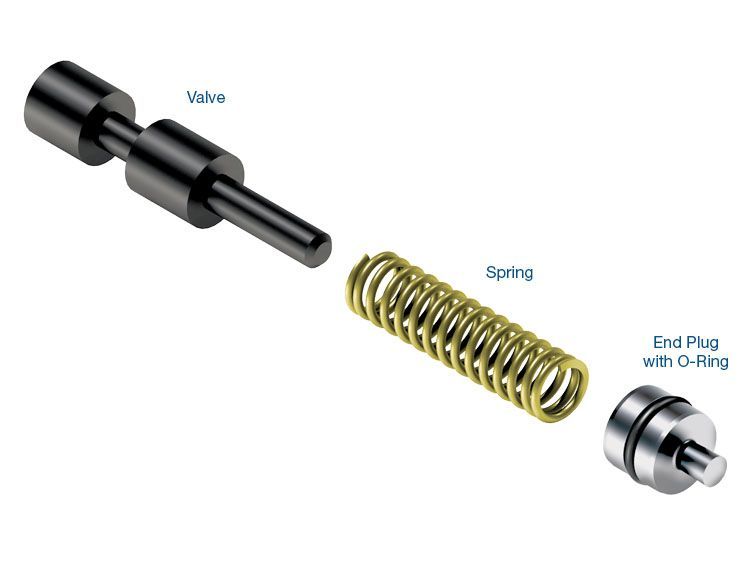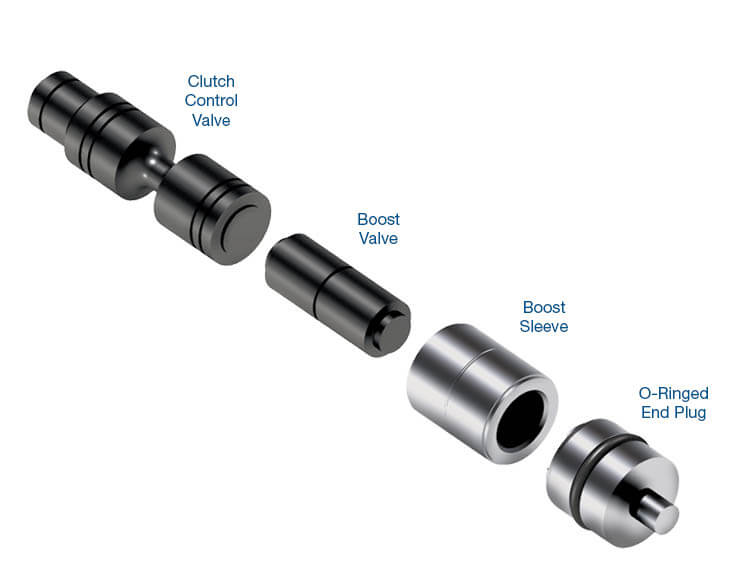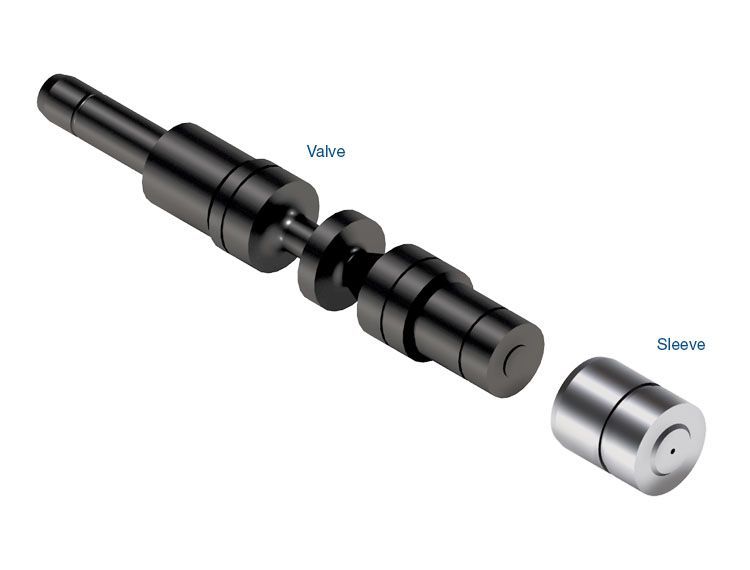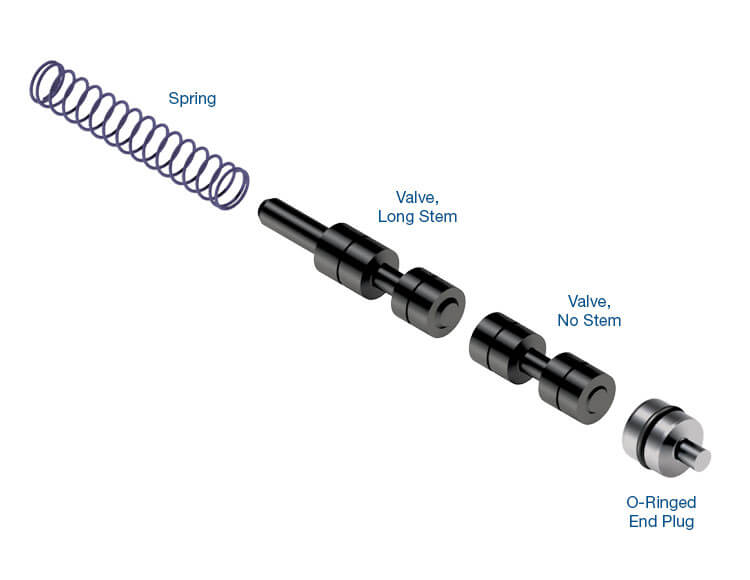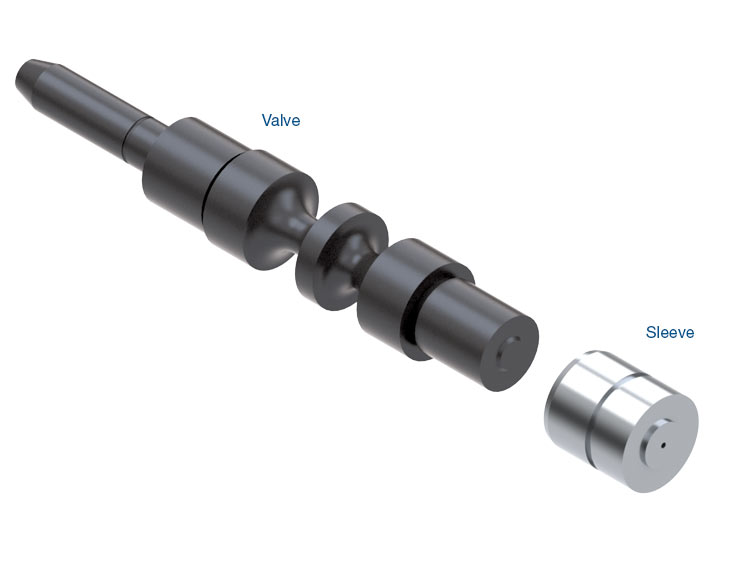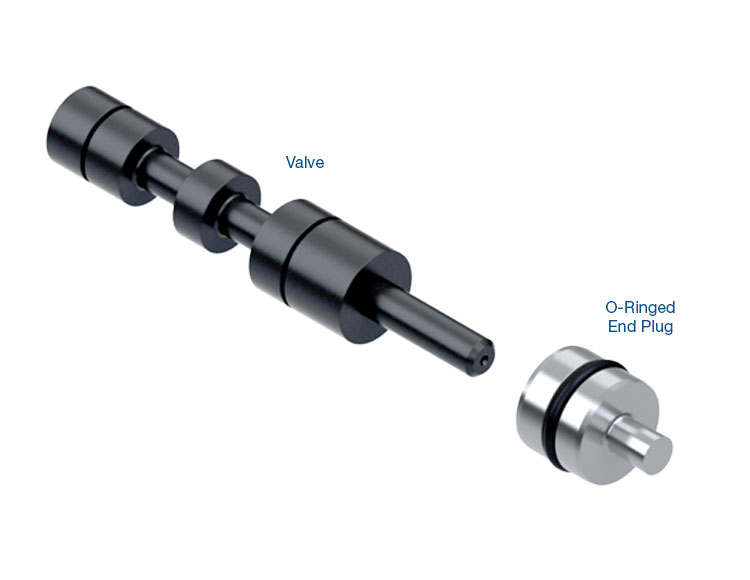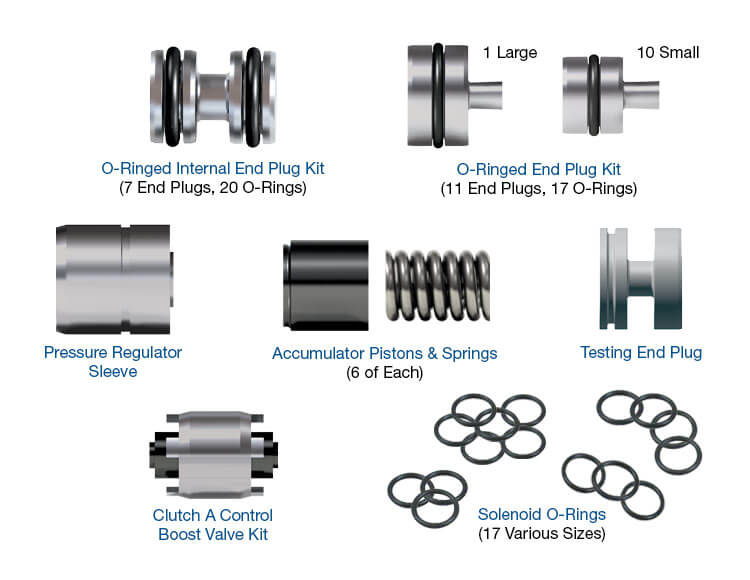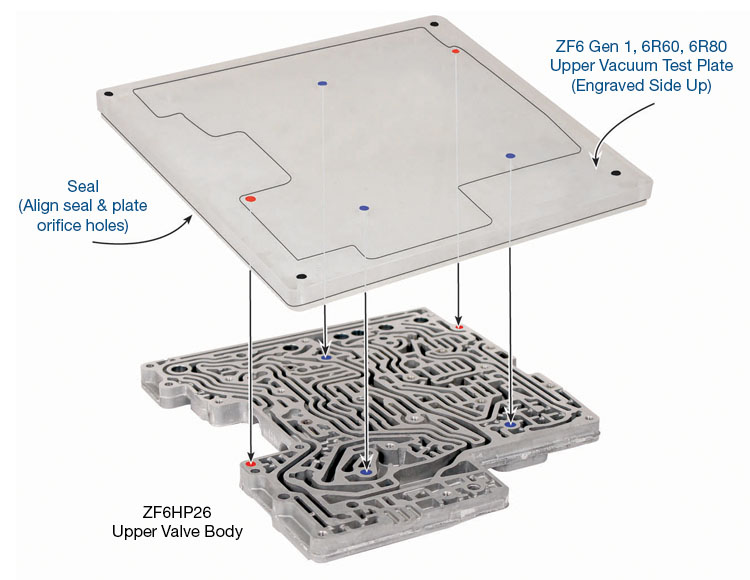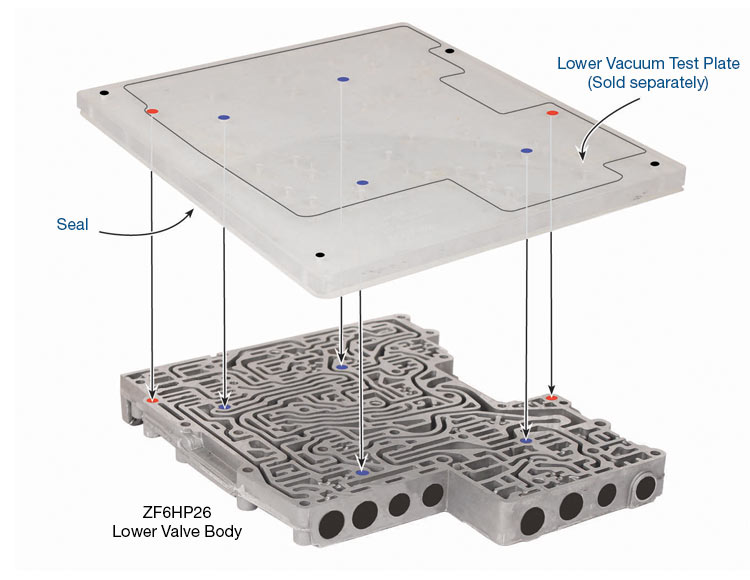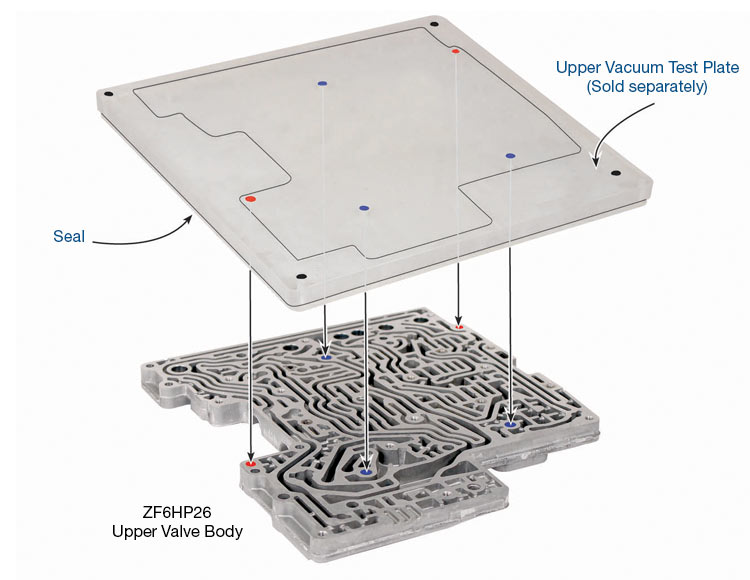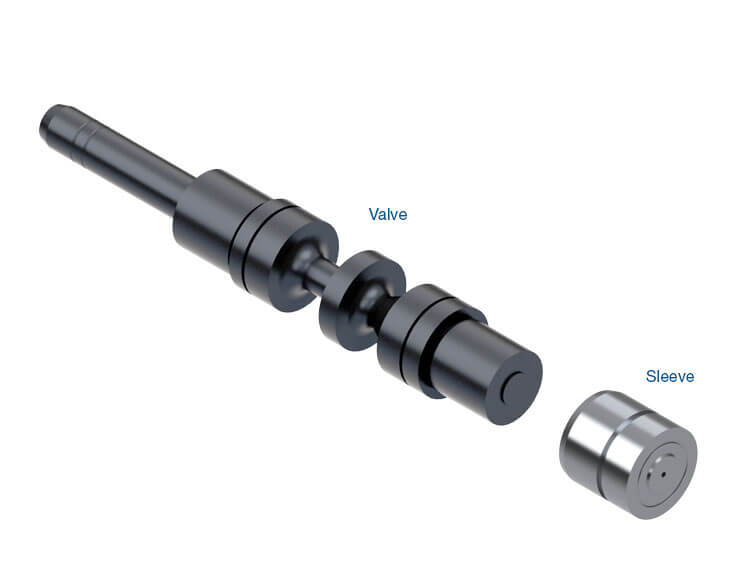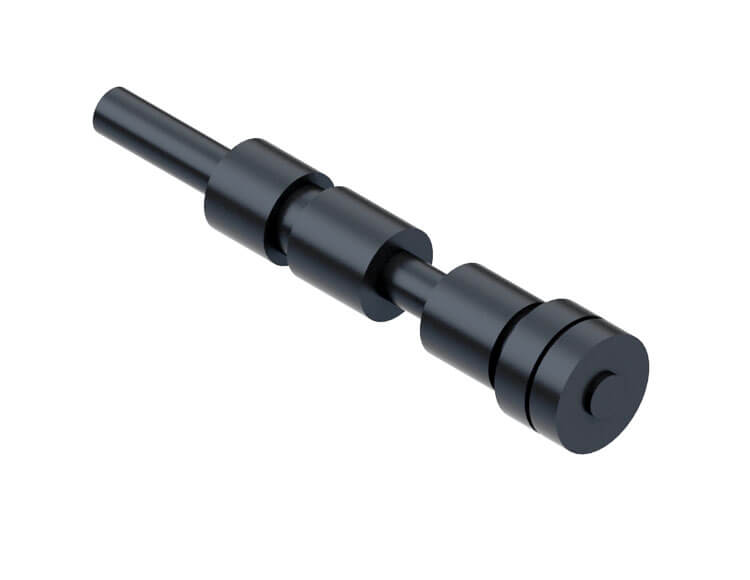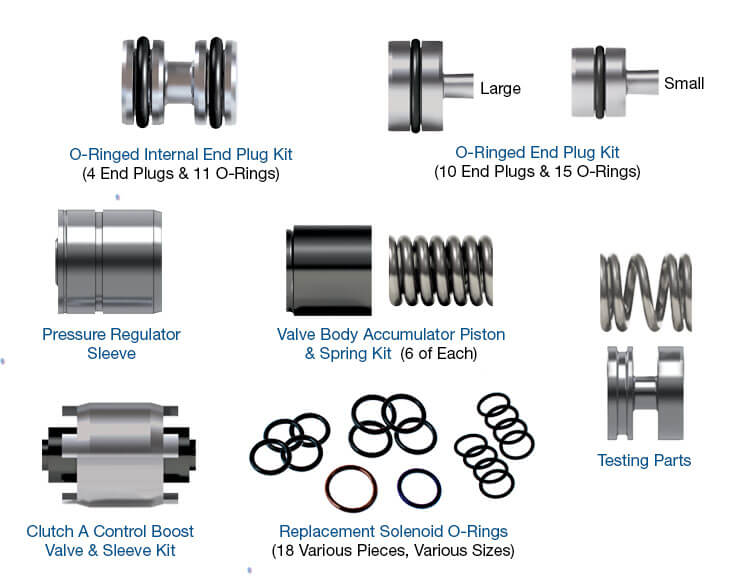How to Identify Similar Ford & ZF6 Transmissions — Four Features to Check Before You Begin a Rebuild
Maura Stafford
The Ford 6R60, 6R75, 6R80 and 6R100, and ZF6HP19/26/32 (Gen. 1) and ZF6HP21/28/34 (Gen. 2) valve bodies are all very similar at first glance — one of those situations where you could say they’re all just a “horse of a different color.” However, the slight differences that can be overlooked may get you in trouble during a rebuild. Following are some key identifying features that can help your rebuilds go more smoothly.
Review Casting Designs
There are two basic casting designs — either an electronic “E-shift” or mechanical “M-shift”. The ZF family can have either an E- or M-shift, while all Ford designs use the M-shift. The E-shift castings have a distinct notch that houses an extra solenoid (Figure 1). All Ford castings have “FoMoCo” or “Ford” cast into the surface, and all ZF castings have a casting number beginning with 1068. Figure 1 also shows some key features that help distinguish between Ford 6R60, 6R75, first design 6R80 and ZF6HP Gen. 1 castings and the second generation ZF applications.
| Figure 1 — ZF & Ford E‐Shift & M‐Shift Casting Identification |
|---|
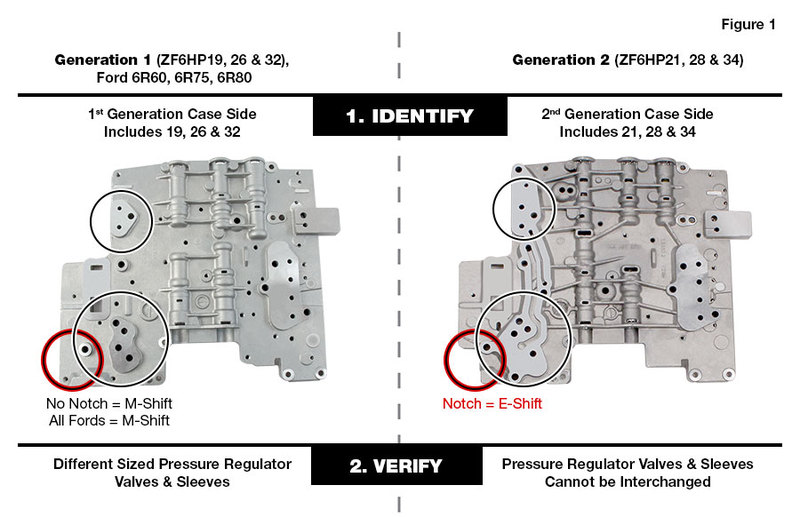 |
The 6R80 has gone through four different design changes. For help in identifying the three latter (’10-later) 6R80 castings, reference Figure 2. There were various passage changes, and the D2 regulator valve bore was removed to coincide with the addition of the low diode.
| Figure 2 — 6R80 & 6R100 Casting Identification |
|---|
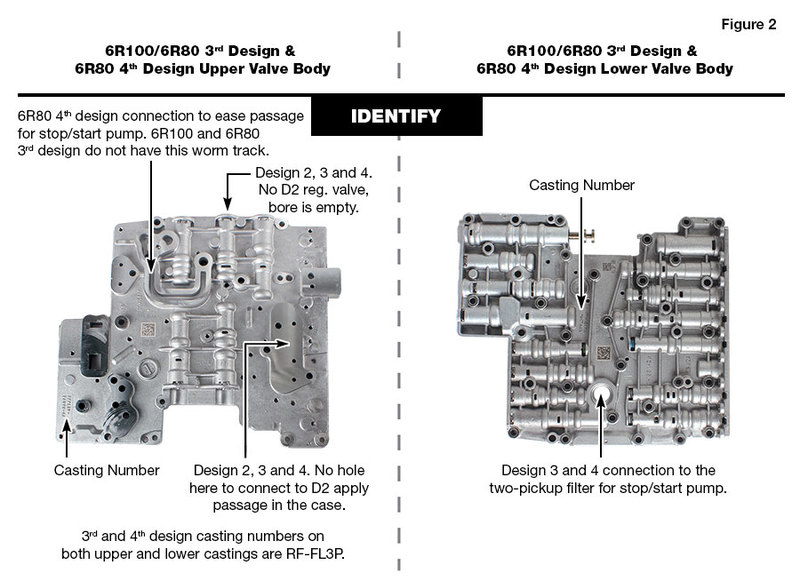 |
The chart in Figure 3 provides casting numbers for both upper and lower sections of the valve body as well as other unit identifiers. The 6R100 transmission came out in 2017 and is a heavy-duty version of the 6R80. The ’15-later 6R80 valve body without stop/start design is also used in the 6R100.
| Figure 3 — 6R80 & 6R100 Casting Number & Design ID |
|---|
The 6R80 has four different designs:
|
| 6R80 & 6R100 Casting Numbers | |||
| Lower Valve Body | Upper Valve Body | Other Identifiers | |
| Design 1 | 9L3P-7A101-BB | 6L2P-7A092-EB | 2010 TCM Removed |
| Design 2 | 9L3P-7A101-BB | BL3P-7A092-BA | D2 reg. valve eliminated from upper valve body. D2 passage eliminated in upper valve body. |
| Design 3 | FL3P-7A101-AA | FL3P-7A092-BA | D2 reg. valve eliminated. Lower valve body has extra hole to connect to two-pickup filter. |
| Design 4 | FL3P-7A101-AA | FL3P-7A092-AA | D2 reg. valve eliminated. Lower valve body has extra hole to connect to two-pickup filter and upper valve body to connect to case passages to stop/start external pump. |
Check Solenoid Color, Location & Numbering
Another important differentiator on these valve bodies is what solenoids are used. For the ZF6HP first generation, the EDS solenoid connector colors were blue and yellow. Be cautious about just identifying units by connector color though, as these tend to change with heat to green and tan. The second generation ZF6HP kept the blue and yellow connector EDS solenoids for most locations, but changed to orange connectors at the EDS1 and EDS2 locations (Figure 4). Ford initially used a combination of brown and black solenoid connectors (Figure 5). In 2010 Ford changed to cream colored solenoids on the ’10-later 6R80s, which also have band numbers between 1 and 5 to indicate flow rate. It is important during a rebuild to make sure that a solenoid of the same band number is put back into the same bore, as this will aid in shift adaptation.
| Figure 4 — EDS Solenoid Connectors |
|---|
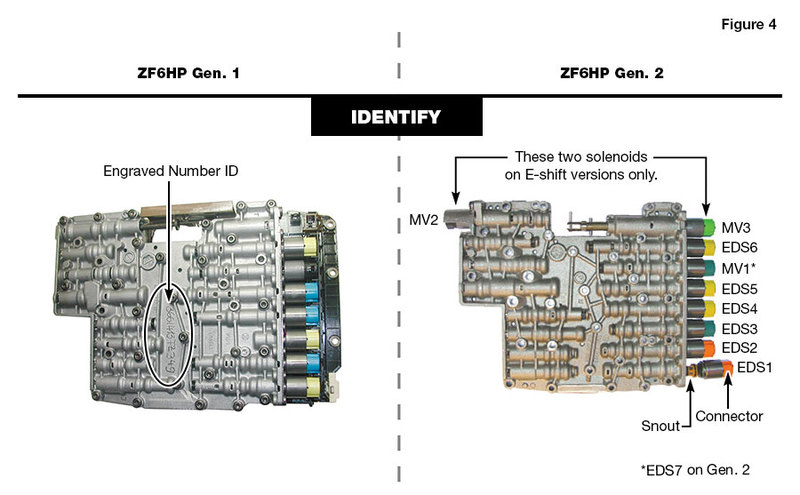 |
| Figure 5 — Ford Solenoid Connectors |
|---|
|
Verify Separator Plate Codes
Separator plates are critical to identify and match to your original casting, as worm tracks and passages vary considerably by application. ZF has continued to use the silicon beaded gasket designs, which should be replaced due to delamination issues anytime the valve body is worked on. They have an A/B code identification for easy reference. The early Ford applications also used the silicon beaded gasket design, which has an E510F plate code. Later design Ford units moved to bonded gaskets. The chart in Figure 6 provides a quick reference for the different variants that have been identified to date.
| Figure 6 — Separator Plate References |
|---|
| OE Valve Body Code | Number Stamped on Original Plate | Valve Body Generation |
| E510F | 6L2P-7Z490-FC or 6L2P-7Z490-FB |
| A035/B035 | 1068-327-141 | ZF6HP19/26/32 (Gen. 1) |
| A036/B036 | 1068-327-145 | |
| A046/B046 | 1068-327-162 | |
| A047/B047 | 1068-327-163 | |
| A051/B051 | 1068-327-179 | |
| A052/B052 | 1068-327-180 | |
| A053/B053 | 1068-327-189 | |
| A063/B063 | 1068-327-210 | ZF6HP21/28/34 (Gen. 2) |
| A065/B065 | 1068-327-224 | |
| AL3P-XX | Early 2010 6R80 | |
| CL3P-XX | Design 2 6R80 | |
| FL3P-XX | Design 3 & 4 6R80, 6R100 |
Measure Pressure Regulator Valve Components
One of the primary wear areas in any of these valve bodies is the pressure regulator valve and sleeve. The basic design has remained the same through both generations of ZF and early and late Ford applications. However, there are some small diameter and length differences that can cause fit and pressure issues if mismatched into the wrong application. It is recommended to measure the locations shown in Figure 7 to verify that the correct OE or replacement part is fit into the appropriate application during rebuild.
| Figure 7 — Pressure Regulator Valve & Sleeve Identification |
|---|
 |
| Application | A | B | C | D | E | F | G |
|---|---|---|---|---|---|---|---|
| ZF6 Gen. 1, 6R60, 6R75, 6R80 ('09–'14) | .645" | .629" Dia. | .495" Dia. | .568" | .378" | .629" Dia. | .550" Dia. |
| ZF6 Gen. 1 w/ 053 Separator Plate | .725" | .657" Dia. | .511" Dia. | .649" | .378" | .657" Dia. | .586" Dia. |
| ZF6 Gen. 2 | .804" | .629" Dia. | .511" Dia. | .725" | .418" | .629" Dia. | .562" Dia. |
| 6R80 ('15-Later), 6R100 | .645" | .629" Dia. | .511" Dia. | .568" | .378" | .629" Dia. | .550" Dia. |
While these various valve bodies have been around awhile, they continue to be updated by ZF and Ford, so always paying attention to the little details during any overhaul will help make it right the first time.
Maura Stafford is a Sonnax product line manager for transmission components and remanufactured valve bodies. She is a member of the Sonnax TASC Force (Technical Automotive Specialties Committee), a group of recognized industry technical specialists, transmission rebuilders and Sonnax Transmission Company technicians.
Related Units
Related Parts
Required
Recommended
6R60 • 6R75 • 6R80 (2009–2014) • ZF6HP19 • ZF6HP26 • ZF6HP32
Oversized Pressure Regulator Valve Kit 95740-01K
Fits 6R80 '09-'14. Cannot be used in units that have a 053 separator plate.
OE valve name: SYS.DR-V
-
Helps cure:
- Poor shift quality
- Flare shifts
- Harsh shifts
- Erratic line pressure
- Slips in Forward & Reverse
- Delayed Reverse
- No Reverse
- TCC slip
Required
Recommended
6R60 • 6R75 • 6R80 (2009–2014) • ZF6HP19 • ZF6HP26 • ZF6HP32
Pressure Regulator Sleeve 95740-03
Required
Recommended
ZF6HP19 • ZF6HP26 • ZF6HP32
Valve Body Separator Plate 95740-035
Use the ZF6 Valve Body Separator Plate Application Chart to determine which plate is required. The plates are not specific by transmission model, but rather by valve body code and also by the stamped number.
-
Helps cure:
- Low pressure
- Low clutch oil pressure
Required
Recommended
ZF6HP19 • ZF6HP26 • ZF6HP32
Valve Body Separator Plate 95740-046
Use the ZF6 Valve Body Separator Plate Application Chart to determine which plate is required. The plates are not specific by transmission model, but rather by valve body code and also by the stamped number.
-
Helps cure:
- Low pressure
- Low clutch oil pressure
Required
Recommended
ZF6HP19 • ZF6HP26 • ZF6HP32
Valve Body Separator Plate 95740-047
Use the ZF6 Valve Body Separator Plate Application Chart to determine which plate is required. The plates are not specific by transmission model, but rather by valve body code and also by the stamped number.
-
Helps cure:
- Low pressure
- Low clutch oil pressure
Required
Recommended
ZF6HP19 • ZF6HP26 • ZF6HP32
Valve Body Separator Plate 95740-051
Use the ZF6 Valve Body Separator Plate Application Chart to determine which plate is required. The plates are not specific by transmission model, but rather by valve body code and also by the stamped number.
-
Helps cure:
- Low pressure
- Low clutch oil pressure
Required
Recommended
ZF6HP19 • ZF6HP26 • ZF6HP32
Valve Body Separator Plate 95740-052
Use the ZF6 Valve Body Separator Plate Application Chart to determine which plate is required. The plates are not specific by transmission model, but rather by valve body code and also by the stamped number.
-
Helps cure:
- Low pressure
- Low clutch oil pressure
Required
Recommended
ZF6HP19 • ZF6HP26 • ZF6HP32
Valve Body Separator Plate 95740-053
Use the ZF6 Valve Body Separator Plate Application Chart to determine which plate is required. The plates are not specific by transmission model, but rather by valve body code and also by the stamped number.
-
Helps cure:
- Low pressure
- Low clutch oil pressure
Required
Recommended
6R100 • 6R60 • 6R75 • 6R80 (2009–2014) • 6R80 (2015-Later) • ZF6HP19 • ZF6HP21 • ZF6HP26 • ZF6HP28 • ZF6HP32 • ZF6HP34
Oversized Converter Release Regulator Valve Kit 95740-05K
OE valve name: WK-V
-
Helps cure:
- Excess TCC slip RPM & related codes
- Harsh TCC apply & release
- Low TCC release pressure
- Rough idle in Reverse
- Harsh downshifts
- Flare shifts
- Overheated converter
Required
Recommended
ZF6HP21 • ZF6HP28 • ZF6HP34
Valve Body Separator Plate 95740-063
Use the ZF6 Valve Body Separator Plate Application Chart to determine which plate is required. The plates are not specific by transmission model, but rather by valve body code and also by the stamped number.
-
Helps cure:
- Low pressure
- Low clutch oil pressure
Required
Recommended
ZF6HP21 • ZF6HP28 • ZF6HP34
Valve Body Separator Plate 95740-065
Use the ZF6 Valve Body Separator Plate Application Chart to determine which plate is required. The plates are not specific by transmission model, but rather by valve body code and also by the stamped number.
-
Helps cure:
- Low pressure
- Low clutch oil pressure
Required
Recommended
6R100 • 6R60 • 6R75 • 6R80 (2009–2014) • 6R80 (2015-Later) • ZF6HP19 • ZF6HP26 • ZF6HP32
Oversized Clutch D1/E Control Valve Kit 95740-08K
Does not fit 2nd, 3rd or 4th design 6R80. Fits either of 2 locations.
-
Helps cure:
- Excess clutch overlap & clutch distress
- Pressure control out-of-range codes
- Downshift bind-ups
- 1-2 Bind-up
- 3-2 Harsh
- Coastdown Neutral
- Flare shifts
Required
Recommended
6R100 • 6R60 • 6R75 • 6R80 (2009–2014) • 6R80 (2015-Later) • ZF6HP19 • ZF6HP26 • ZF6HP32
Oversized Clutch A Control Valve Kit 95740-09K
-
Helps cure:
- Downshift bind-ups
- Flare shifts
- Excess clutch overlap & clutch distress
- Pressure control out-of-range codes
Required
Recommended
6R100 • 6R60 • 6R75 • 6R80 (2009–2014) • 6R80 (2015-Later) • ZF6HP19 • ZF6HP26 • ZF6HP32
Oversized Lubrication Control Valve Kit 95740-11K
OE valve name: SCHM-V
-
Helps cure:
- Planetary failure
- Bushing failure
- Lube failures
- Overheating
- Low converter pressure
- Bump shifts
- Flare shifts
- Rough idle in Reverse
- TCC apply & release concerns
Required
Recommended
6R100 • 6R60 • 6R75 • 6R80 (2009–2014) • 6R80 (2015-Later) • ZF6HP19 • ZF6HP26 • ZF6HP32
Oversized Bypass Clutch Control Valve Kit 95740-13K
OE valve name: WD-V
-
Helps cure:
- TCC codes
- Excess TCC slip
- Cycling RPM
- Low TCC release pressure
- Flare shifts
- Harsh shifts
- Rough idle in Reverse
- Overheated converter
Required
Recommended
6F35 (Gen. 1) • 6F35 (Gen. 2) • 6F35 (Gen. 3) • 6R100 • 6R140 • 6R60 • 6R75 • 6R80 (2009–2014) • 6R80 (2015-Later) • 845RE • 850RE • CFT30 • ZF6HP19 • ZF6HP21 • ZF6HP26 • ZF6HP28 • ZF6HP32 • ZF6HP34 • ZF8HP45 • ZF8HP50 • ZF8HP55 • ZF8HP70 • ZF8HP75
Accumulator Piston Kit 95740-15K
Required
Recommended
6R100 • 6R60 • 6R75 • 6R80 (2009–2014) • 6R80 (2015-Later) • ZF6HP19 • ZF6HP26 • ZF6HP32
Oversized Solenoid Pressure Regulator Valve Kit 95740-17K
ZF valve name: DR.REO-V
-
Helps cure:
- Flare shifts
- Neutral shifts
- Harsh upshifts
- Harsh downshifts
- Gear ratio codes
- Solenoid performance codes
- Delayed Forward
- Delayed Reverse
- Wrong gear starts
- TCC slip
Required
Recommended
6R100 • 6R60 • 6R75 • 6R80 (2009–2014) • 6R80 (2015-Later) • ZF6HP19 • ZF6HP26 • ZF6HP32
O-Ringed End Plug Kit 95740-19K
Required
Recommended
6R100 • 6R60 • 6R75 • 6R80 (2009–2014) • 6R80 (2015-Later) • ZF6HP19 • ZF6HP26 • ZF6HP32
Clutch A Control Boost Valve Kit 95740-21K
Required
Recommended
6R100 • 6R60 • 6R75 • 6R80 (2009–2014) • 6R80 (2015-Later) • ZF6HP19 • ZF6HP26 • ZF6HP32
O-Ringed Internal End Plug Kit 95740-25K
Required
Recommended
Required
Recommended
6R60
Valve Body Separator Plate 95740-510
Use the ZF6 Valve Body Separator Plate Application Chart to determine which plate is required. The plates are not specific by transmission model, but rather by valve body code and also by the stamped number.
-
Helps cure:
- Low pressure
- Low clutch oil pressure
Required
Recommended
ZF6HP21 • ZF6HP28 • ZF6HP34
Oversized Solenoid Pressure Regulator Valve Kit 95740-64K
ZF valve name: DR.REO-V
-
Helps cure:
- Delayed engagement
- Flare shifts
- Harsh downshifts
- Neutral shifts
- High line pressure
- Harsh upshifts
- Wrong gear starts
- Gear ratio & solenoid codes
- TCC slip
Required
Recommended
ZF6HP21 • ZF6HP28 • ZF6HP34
Oversized Clutch A & Clutch E Control Valve Kit 95740-72K
Fits either clutch A or E control bore locations in E-shift versions of ZF6HP21/28/34 (Generation 2) valve bodies only.
-
Helps cure:
- Coastdown Neutral
- Downshift bind-ups
- Harsh downshifts
- Flare shifts
- Pressure control out-of-range codes
Required
Recommended
ZF6HP21 • ZF6HP28 • ZF6HP34
Oversized Pressure Regulator Valve Kit 95740-69K
ZF valve name: SYS.DR-V
-
Helps cure:
- Poor shift quality
- Low line pressure
- Flare shifts
- High line pressure
- Harsh shifts
- Burnt converter
- Delayed Reverse
- No Reverse
- TCC slip
Required
Recommended
ZF6HP21 • ZF6HP28 • ZF6HP34
Oversized Lubrication Control Valve Kit 95740-71K
ZF valve name: SCHM-V
-
Helps cure:
- Bearing failure
- Bushing failure
- Planetary failure
- Lube failures
- Low converter pressure
- Overheating
- TCC codes & concerns
- Rough idle in Reverse
Required
Recommended
ZF6HP19 • ZF6HP21 • ZF6HP26 • ZF6HP28 • ZF6HP32 • ZF6HP34
Oversized Position Valve Kit 95740-75K
Fits E-shift versions only of the ZF6HP21/28/34 (Generation 2) and ZF6HP19/26/32 (Generation 1) valve bodies with an 053 separator plate.
-
Helps cure:
- Shift concerns
- "A" Clutch burned
- B Clutch burned
- E Clutch burned
Required
Recommended
ZF6HP19 • ZF6HP26 • ZF6HP32
Oversized Pressure Regulator Valve Kit 95740-78K
Fits units with 053 separator plate only.
OE valve name: SYS.DR-V
-
Helps cure:
- Broken parts due to excessive line pressure
- Erratic line pressure
- Harsh shifts
- High line pressure
- Restricted converter/lube flow
- Soft shifts
- Flare shifts
- TCC slip
Required
Recommended
ZF6HP26
Oversized "E" Latch Valve Kit 95740-80K
Sonnax 95740-80K can only be used to replace short (.180") center spool OE valves, typically found in ZF6HP26 valve bodies with 047 separator plate.
-
Helps cure:
- 3-4 Bump
- 3-4 Flare
- 3-4 Late
- Gear ratio & solenoid codes
- No 4th
- No 5th
- No 6th
- E Clutch burned
Required
Recommended
6R60 • 6R75 • 6R80 (2009–2014) • ZF6HP19 • ZF6HP26 • ZF6HP32
Vacuum Test Plate Kit 95740-VTP1
Cannot be used on 053 separator plate applications.
Required
Recommended
Required
Recommended
Required
Recommended
6R100 • 6R80 (2015-Later)
Oversized Pressure Regulator Valve Kit 95740-46K
Fits '15-later 6R80 units.
-
Helps cure:
- Poor shift quality
- Flare shifts
- Harsh shifts
- Erratic line pressure
- Slips in Forward & Reverse
- Delayed Reverse
- No Reverse
- TCC slip
Required
Recommended
6R100 • 6R60 • 6R75 • 6R80 (2009–2014) • 6R80 (2015-Later) • ZF6HP19 • ZF6HP26 • ZF6HP32
Oversized Clutch C Regulator Valve 95740-40K
Cannot be used in units that have a 053 separator plate.
-
Helps cure:
- 6th Slip
- 2nd Slip
- Clutch failure
- Poor shift quality
- Ratio errors
While Sonnax makes every effort to ensure the accuracy of technical articles at time of publication, we assume no liability for inaccuracies or for information which may become outdated or obsolete over time.
